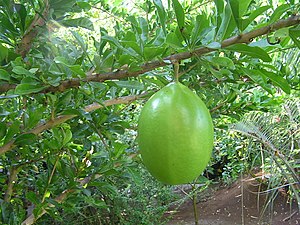Calabash tree
| Calabash tree | ||||||||||||
|---|---|---|---|---|---|---|---|---|---|---|---|---|

Fruit of the calabash tree ( Crescentia cujete ) |
||||||||||||
| Systematics | ||||||||||||
|
||||||||||||
| Scientific name | ||||||||||||
| Crescentia cujete | ||||||||||||
| L. |
The calabash tree ( Crescentia cujete ) is a species of the trumpet tree family (Bignoniaceae). Similar to the bottle gourd ( Lagenaria siceraria ), drinking vessels ( calabashes ) can be made from the fruits , which explains the German name of the species.
description
The gourd tree is an about 8 to 10 (often up to 13) meters high tree with short, straight stem, a breast height diameter reaches 25 centimeters. The wood is odorless and easy to work with, mostly the pink to reddish brown sapwood can be distinguished from the light brown heartwood . It has a gray-brown, cracked bark. The few widely spreading branches form a wide and open crown.
The sessile, simple foliage leaves are arranged in groups of three to five in clusters; they are rarely inserted alternately at branch tips. The leaf shape is egg to spatulate with the widest point near the tip of the leaf. The upper side of the leaf is deep green and slightly shiny, the underside is duller and paler. Young shoots are light gray to light brown. The information on the size of the leaves varies, the length is given as a minimum of 3.5 to a maximum of 26 centimeters, the width is between 1 and 7.6 centimeters. The calabash tree is usually referred to as evergreen, but this only applies to areas without pronounced dry seasons. In other areas, the species, which is known to be very drought-resistant, sheds its leaves at the beginning of the dry season.
The flowers grow individually or in pairs directly on the trunk or on strong branches ( cauliflora ) on hairy, 1.5 to 3 centimeter long flower stalks. The hermaphrodite flowers are five-fold and slightly zygomorphic . The mostly smooth, green sepals are fused to form an approximately 2 centimeter long, deeply incised calyx. The five hairy petals are fused into a bell-shaped corolla tube of white to greenish-yellow color with red stripes, which has a length of 5 centimeters and a diameter of 3 to 7.5 centimeters. The four fertile stamens are shorter than the corolla tube. The flowers open in the dark and fall off again the following morning; they smell of camphor and mustard oil . Flowering time is throughout the year (according to other information in June). The pollination is carried by bats .
The fruits are round to elliptical. The fruits of the wild form have a size of about 10 centimeters, fruits of cultivated forms can reach a length of 45 centimeters with a diameter of 30 centimeters. They are initially green, later yellow and when fully ripe they are brown. The shell is thin, hard and durable. The flesh is white, juicy and contains numerous flat, dark brown seeds 6 to 8 millimeters in length.
Distribution and location requirements
The natural home of the calabash tree is likely to be the West Indies and the area from southern Mexico to Peru and Brazil . The original homeland is unknown, as the species has been cultivated since pre-Hispanic times, possibly for more than 600 years. The calabash tree is also grown in other countries with tropical climates, but there are no large, profit-oriented plantations either in their homeland or in other areas .
Crescentia cujete is well adapted to tropical dry areas, drought-resistant and sensitive to frost. The species grows from sea level to altitudes of around 800 meters, in areas with an annual rainfall of 1300 to 1500 millimeters and a mean temperature of around 26 ° C. In natural locations in the Caribbean, the species is often found together with tree-shaped cacti of the genus Lamaireocereus .
use
The fruits, which were harvested, dried, hollowed out and polished before they were ripe, were used to make drinking vessels, containers for food and liquids, but also maracas (rumbarasseln). Perforated fruits are used by prospectors to sift river sand.
The pulp and seeds are used in folk medicine as a laxative and diuretic .
The wood can be used as fuel. It was also used in the construction of small boats.
Common names
The other German-language trivial names pumpkin tree and tutum tree exist for the calabash tree .
swell
Individual evidence
- ↑ a b c d Description in The RNGR Team , accessed February 3, 2008
- ↑ a b c d Description in Arboles Ornamentales. (span.)
- ↑ Ecological-Botanical Garden of the University of Bayreuth, Freundeskreis eV: The tree for calabashes and rumbarasseln ( memento of the original from November 25, 2015 in the Internet Archive ) Info: The archive link was automatically inserted and not yet checked. Please check the original and archive link according to the instructions and then remove this notice. .
- ^ Georg August Pritzel , Carl Jessen : The German folk names of plants. New contribution to the German linguistic treasure. Philipp Cohen, Hannover 1882, p. 118. ( online ).
literature
- Schütt, Weisgerber, Schuck, Lang, Stimm, Roloff: Trees of the tropics. 2006, ISBN 3-933203-79-1 .
Web links
- Description in Flora Brasiliensis
- Description and detailed pictures. (English; PDF file; 741 kB)


